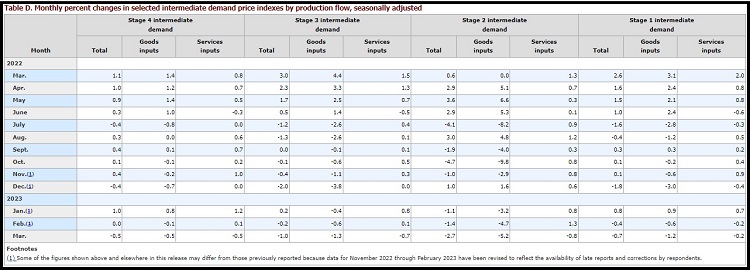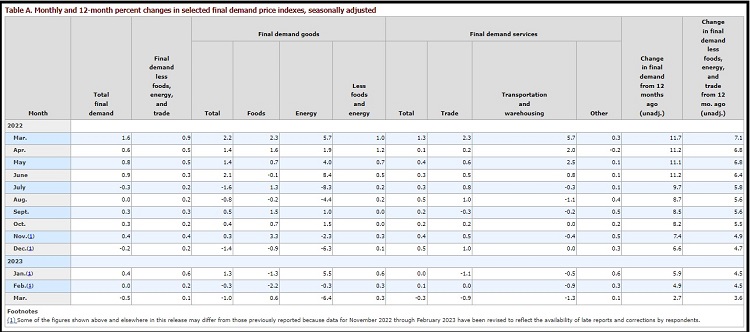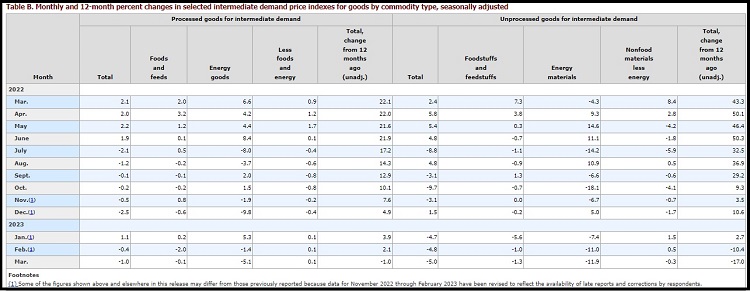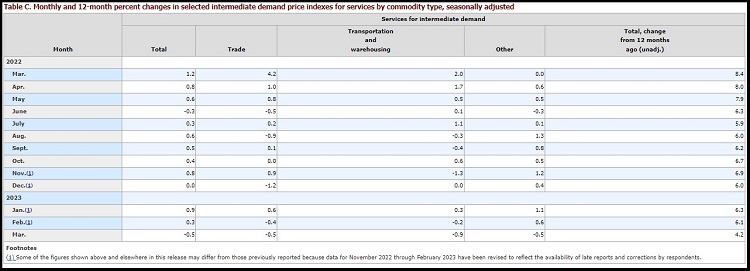Final demand prices were unchanged in February and increased 0.4% in January
The Producer Price Index for final demand declined 0.5% in March, seasonally adjusted, the U.S. Bureau of Labor Statistics reported on Thursday.
Final demand prices were unchanged in February and increased 0.4% in January. (Tab A) On an unadjusted basis, the index for final demand advanced 2.7% for the 12 months ended in March.
In March, two-thirds of the decline in the index for final demand can be attributed to a 1% decrease in prices for final demand goods. The index for final demand services moved down 0.3%.
Prices for final demand other than foods, energy, and trade services edged up 0.1% in March after rising 0.2% in February. For the 12 months ended in March, the index for final demand less foods, energy, and trade services increased 3.6%.
Final Demand
Final Demand goods: Prices for final demand goods decreased 1.0 percent in March after falling 0.3 percent in February. The March decline is attributable to the index for final demand energy, which dropped 6.4 percent. In contrast, prices for final demand goods less foods and energy and for final demand foods advanced 0.3 percent and 0.6 percent, respectively.
Product detail: Eighty percent of the March decline in the index for final demand goods can be traced to an 11.7-percent drop in prices for gasoline. The indexes for diesel fuel, residential natural gas, jet fuel, electric power, and fresh and dry vegetables also fell. Conversely, prices for light motor trucks increased 0.7 percent. The indexes for chicken eggs and for meats also moved higher. (See Table B)
Final demand services: Prices for final demand services moved down 0.3 percent in March, the largest decline since falling 0.5 percent in April 2020. Leading the March decrease, margins for final demand trade services dropped 0.9 percent. (Trade indexes measure changes in margins received by wholesalers and retailers.) The index for final demand transportation and warehousing services fell 1.3 percent. In contrast, prices for final demand services less trade, transportation, and warehousing edged up 0.1 percent.
Product detail: A 7.3-percent drop in margins for machinery and vehicle wholesaling was a major factor in the March decrease in prices for final demand services. The indexes for truck transportation of freight, portfolio management, fuels and lubricants retailing, loan services (partial), and automobiles and automobile parts retailing also moved down. Conversely, prices for guestroom rental rose 4.6 percent. The indexes for food retailing and for transportation of passengers (partial) also advanced.
Intermediate Demand by Commodity Type
Within intermediate demand in March, prices for processed goods declined 1.0 percent, the index for unprocessed goods fell 5.0 percent, and prices for services decreased 0.5 percent. (See tables B and C)
Processed goods for intermediate demand: The index for processed goods for intermediate demand declined 1.0 percent in March after moving down 0.4 percent in February. A major factor in the March decrease was a 5.1-percent drop in prices for processed energy goods. The index for processed foods and feeds edged down 0.1 percent. In contrast, prices for processed materials less foods and energy advanced 0.1 percent. For the 12 months ended in March, the index for processed goods for intermediate demand moved down 1.0 percent, the largest 12-month decrease since a 1.6-percent decline in September 2020.
Product detail: One-third of the March decrease in prices for processed goods for intermediate demand can be traced to a 6.5-percent decline in the index for diesel fuel. Prices for gasoline, utility natural gas, electric power, ethanol, and formula feeds also moved lower. Conversely, the index for primary basic organic chemicals rose 5.6 percent. Prices for structural, architectural, and pre-engineered metal products and for meats also increased.
Unprocessed goods for intermediate demand: The index for unprocessed goods for intermediate demand moved down 5.0 percent in March, the largest decline since falling 9.7 percent in October 2022. The broad-based decrease in March was led by prices for unprocessed energy goods, which dropped 11.9 percent. The indexes for unprocessed foodstuffs and feedstuffs and for unprocessed nonfood materials less energy also moved lower, 1.3 percent and 0.3 percent, respectively. For the 12 months ended in March, prices for unprocessed goods for intermediate demand declined 17.0 percent, the largest 12-month decrease since a 20.1-percent drop in May 2020.
Product detail: Half of the March decline in the index for unprocessed goods for intermediate demand is due to a 10.2-percent decrease in prices for crude petroleum. The indexes for natural gas; corn; raw milk; hay, hayseeds, and oilseeds; and raw cotton also fell. In contrast, prices for ungraded chicken eggs jumped 44.1 percent. The indexes for nonferrous metal ores and for coal also moved higher.
Services for intermediate demand: The index for services for intermediate demand moved down 0.5 percent in March following a 0.3-percent increase in February. Over half of the broad-based decline can be attributed to a 0.5-percent decrease in prices for services less trade, transportation, and warehousing for intermediate demand. The index for transportation and warehousing services for intermediate demand fell 0.9 percent. Margins for trade services for intermediate demand declined 0.5 percent. For the 12 months ended in March, the index for services for intermediate demand increased 4.2 percent.
Product detail: Nearly 60 percent of the March decline in the index for services for intermediate demand can be attributed to a 5.4-percent decrease in prices for loan services (partial). The indexes for portfolio management, truck transportation of freight, gross rents for retail properties, arrangement of freight and cargo transportation, and fuels and lubricants retailing also moved lower.
Conversely, margins for food wholesaling increased 1.8 percent. The indexes for deposit services (partial) and for transportation of passengers (partial) also advanced.
Intermediate Demand by Production Flow
Stage 4 intermediate demand: The index for stage 4 intermediate demand moved down 0.5 percent in March following no change in February. In March, prices for both total services inputs and for
total goods inputs to stage 4 intermediate demand declined 0.5 percent. (See table D.) Decreases in the indexes for loan services (partial), portfolio management, electric power, gross rents for retail properties, corn, and diesel fuel outweighed increases in the indexes for food wholesaling, motor vehicles and equipment, and investment banking. For the 12 months ended in March, prices for stage 4 intermediate demand moved up 3.2 percent.
Stage 3 intermediate demand: The index for stage 3 intermediate demand decreased 1.0 percent in March after declining 0.2 percent in February. In March, prices for total goods inputs to stage 3 intermediate demand fell 1.3 percent, and the index for total services inputs moved down 0.7 percent.
Lower prices for raw milk, diesel fuel, loan services (partial), corn, jet fuel, and arrangement of freight and cargo transportation outweighed increases in the indexes for ungraded chicken eggs, slaughter cattle, and temporary help services. For the 12 months ended in March, prices for stage 3 intermediate demand decreased 1.7 percent, the largest 12-month decline since falling 2.4 percent in September 2020.

Stage 2 intermediate demand: Prices for stage 2 intermediate demand fell 2.7 percent in March, the largest decline since moving down 4.7 percent in October 2022. In March, the index for total goods inputs to stage 2 intermediate demand dropped 5.2 percent, and prices for total services inputs declined 0.8 percent. Decreases in the indexes for crude petroleum; gas fuels; loan services (partial); fuels and lubricants retailing; hay, hayseeds, and oilseeds; and ethanol outweighed advances in the indexes for carbon steel scrap, deposit services (partial), and food wholesaling. For the 12 months ended in March, prices for stage 2 intermediate demand moved down 4.0 percent, the largest 12-month decline since a 5.3-percent drop in July 2020.
Stage 1 intermediate demand: Prices for stage 1 intermediate demand decreased 0.7 percent in March after falling 0.4 percent in February. In March, the index for total goods inputs to stage 1 intermediate demand moved down 1.2 percent, and prices for total services inputs fell 0.2 percent.
Declining prices for diesel fuel, corn, utility natural gas, ethanol, portfolio management, and truck transportation of freight outweighed increases in the indexes for guestroom rental, primary basic organic chemicals, and investment banking. For the 12 months ended in March, prices for stage 1 intermediate demand advanced 0.4 percent.





